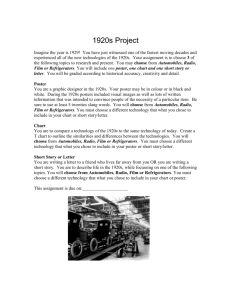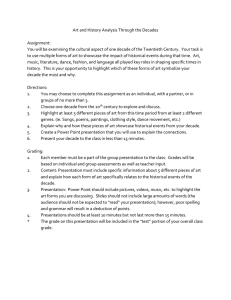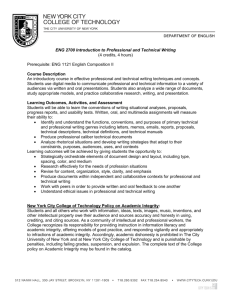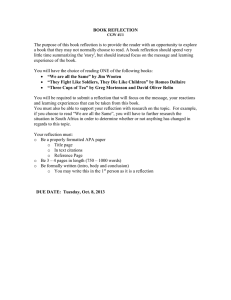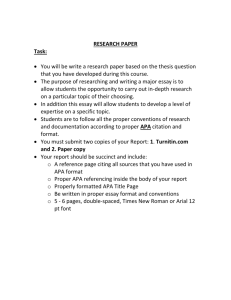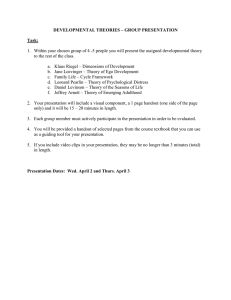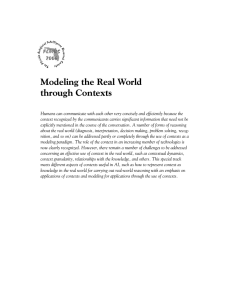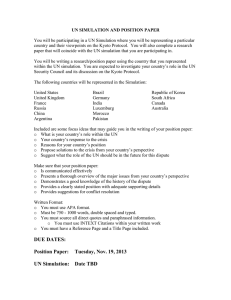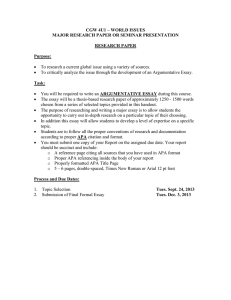IONA CATHOLIC SECONDARY SCHOOL Math Department
advertisement
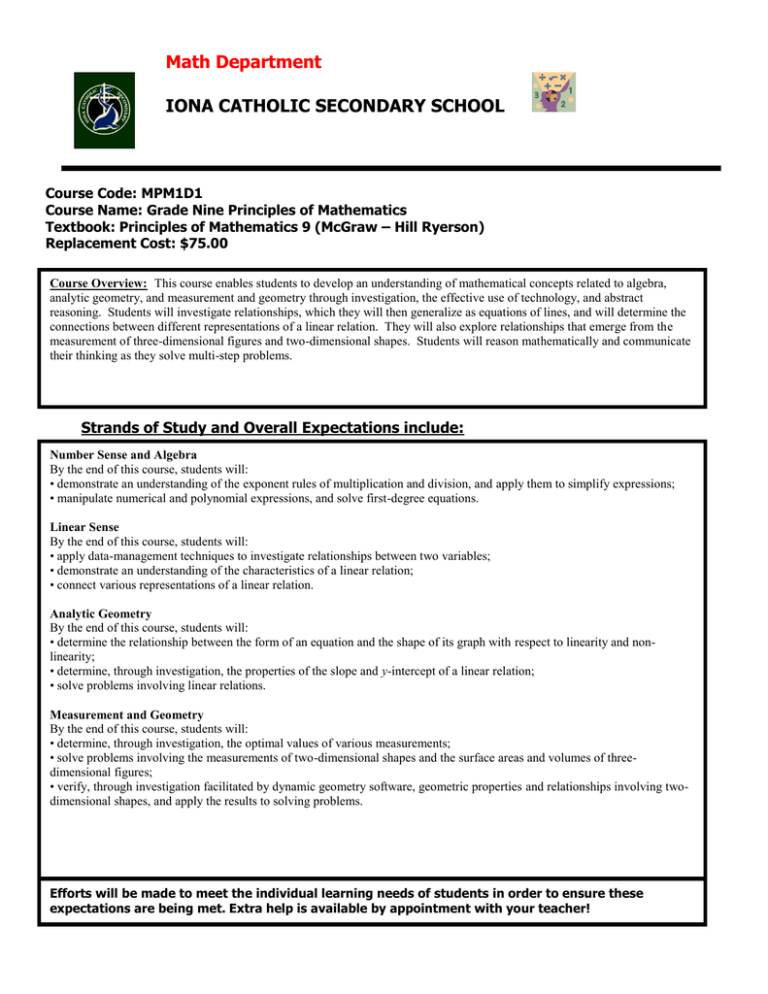
Math Department IONA CATHOLIC SECONDARY SCHOOL Course Code: MPM1D1 Course Name: Grade Nine Principles of Mathematics Textbook: Principles of Mathematics 9 (McGraw – Hill Ryerson) Replacement Cost: $75.00 Course Overview: This course enables students to develop an understanding of mathematical concepts related to algebra, analytic geometry, and measurement and geometry through investigation, the effective use of technology, and abstract reasoning. Students will investigate relationships, which they will then generalize as equations of lines, and will determine the connections between representations of a linearExpectations relation. They will also explore relationships that emerge from the Strands ofdifferent Study and Overall include: measurement of three-dimensional figures and two-dimensional shapes. Students will reason mathematically and communicate their thinking as they solve multi-step problems. Strands of Study and Overall Expectations include: Number Sense and Algebra By the end of this course, students will: • demonstrate an understanding of the exponent rules of multiplication and division, and apply them to simplify expressions; • manipulate numerical and polynomial expressions, and solve first-degree equations. Linear Sense By the end of this course, students will: • apply data-management techniques to investigate relationships between two variables; • demonstrate an understanding of the characteristics of a linear relation; • connect various representations of a linear relation. Analytic Geometry By the end of this course, students will: • determine the relationship between the form of an equation and the shape of its graph with respect to linearity and nonlinearity; • determine, through investigation, the properties of the slope and y-intercept of a linear relation; • solve problems involving linear relations. Measurement and Geometry By the end of this course, students will: • determine, through investigation, the optimal values of various measurements; • solve problems involving the measurements of two-dimensional shapes and the surface areas and volumes of threedimensional figures; • verify, through investigation facilitated by dynamic geometry software, geometric properties and relationships involving twodimensional shapes, and apply the results to solving problems. Efforts will be made to meet the individual learning needs of students in order to ensure these expectations are being met. Extra help is available by appointment with your teacher! Course Breakdown UNITS OF STUDY: TEXTS AND RESOURCES: Course Introduction/Review Polynomials Equations Modeling with Graphs Analyzing Linear Relations Relations/Data Geometric Relationships Measurement Relationships Optimizing Measurement EQAO/Exam Preparation Principles of Mathematics Classroom Expectations: Students are expected to attend class, to do their work regularly to come to class on time with all necessary materials, to wear the proper uniform and to adhere to the school’s accepted code of conduct. For further information on the Catholic Code of Conduct refer to the student handbook pages 17-20 Evaluation Structure:: Knowledge/Understanding Thinking Communication Application 30 % 20 % 20 % 30 % The above is reflected both in the term work (worth 70% of the final mark) and the summative work (worth 30% of the final mark). Summative work consists of the Final Exam (20%) and EQAO (10%). Evaluation Policy Students will be assessed & evaluated according to the work produced & skills displayed. Methods of providing feedback will include assessing work in process & evaluating completed assignments, tests, co-operative learning activities, simulations and presentations. Peer & self-evaluations will also be utilized. Student marks will be determined by evaluating process & product according to 4 categories & 4 levels. Please see the chart below for specific skills and key words used to determine student competency in the different categories. Level 1: Category 50-59% Level 2: 60-69% Knowledge/Understanding: Knowledge of content; Understanding of mathematical concepts -demonstrates limited knowledge of content and understanding of concepts. -demonstrates some knowledge of content and understanding of concepts. Thinking: Use of planning skills: Understanding the problem; making a plan for solving the problem; Use of processing skills: carrying out a plan; looking back at the solution. -uses planning skills and processing skills with limited effectiveness. -uses planning skills and processing skills with some effectiveness. -uses critical/creative thinking processes with limited effectiveness -uses critical/creative thinking processes with some effectiveness. -expresses and organizes mathematical thinking, communication for different audiences and use of conventions and vocabulary with limited effectiveness. -expresses and organizes mathematical thinking, communicates for different audiences and uses conventions and vocabulary with some effectiveness. Use of critical/creative thinking processes Communication: Expression and organization of ideas and mathematical thinking; Communication of different audiences and purposes in oral, visual, and written forms; Use of conventions, vocabulary, and terminology of the discipline in oral, visual and written forms. Application: Application of knowledge and skills in familiar context; Transfer of knowledge and skills to new contexts; Making connections within and between various contexts. -applies knowledge and skills in familiar contexts, transfers knowledge and skills to new contexts and makes connections within and between various contexts with limited effectiveness. - applies knowledge and skills in familiar contexts, transfers knowledge and skills to new contexts and makes connections within and between various contexts with some effectiveness. Level 3: 70-79% -demonstrates considerable knowledge of content and understanding of concepts. -uses planning skills and processing skills with considerable effectiveness. -uses critical/creative thinking processes with considerable effectiveness. -expresses and organizes mathematical thinking, communicates for different audiences and uses conventions and vocabulary with considerable effectiveness. - applies knowledge and skills in familiar contexts, transfers knowledge and skills to new contexts and makes connections within and between various contexts with considerable effectiveness. Level 4: 80-100% -demonstrates thorough knowledge of content. -demonstrates thorough understanding of concepts. -uses planning skills with a high degree of effectiveness. -uses processing skills with a high degree of effectiveness. -uses critical/creative thinking processes with a high degree of effectiveness. - expresses and organizes mathematical thinking, communicates for different audiences and uses conventions and vocabulary with a high degree of effectiveness. - applies knowledge and skills in familiar contexts, transfers knowledge and skills to new contexts and makes connections within and between various contexts with a high degree of effectiveness. Feedback will also be provided for student learning skills. Skills like working independently, team work, organization, work habits and homework, and initiative are assessed independently student achievement and will be conducted through the use of a rubric indicating specific criteria to be achieved to receive each of the following letter grades: E –Excellent G – Good S – Satisfactory N - Needs Improvement Other Evaluation Issues LATE ASSIGNMENTS The due dates for major assignments will be clearly articulated by the teacher when the task is assigned. The teacher will establish a deadline and an acceptance period of 3 school days following the deadline. The teacher will also allow for submission of assignments before the deadlines of the acceptance period for the purpose of assistance in revising. If a student does not hand in the assignment by the deadline, a mark reduction will be applied to the assignment submitted thereafter up to a total of 10%. If the assignment is not submitted by the end of the acceptance period the student will receive a mark of zero. Refer to The Student Handbook 2011-2012, p.32 for further details. INCOMPLETE ASSSIGNMENTS Assignments will be graded according to the extent with which they meet the criteria established in the rubric or evaluation structure. MISSED TESTS . Teachers will give the class ample notice for up-coming tests/evaluations. It is the responsibility of the student to make arrangements for an alternative assessment date (which may not be during class time) with the teacher before the scheduled time for the test/evaluation. If a test is missed due to a legitimate reason, verification (note only to be handed in on the day of the student’s return) from a parent/guardian must be given to the subject teacher indicating that the parents are aware the student has missed a test. If a test is missed as a result of truancy, a mark of zero will be assigned with no opportunity for a re-write. PLAGIARISM in any form reflects academic dishonesty and will result in a mark of zero for the assignment in question ATTENDANCE It is the responsibility of each student to be punctual and in attendance, with proper materials, at all classes and scheduled activities. Students who miss classes may put their credit in jeopardy. It is the student’s responsibility to catch up on missed work when absent.
